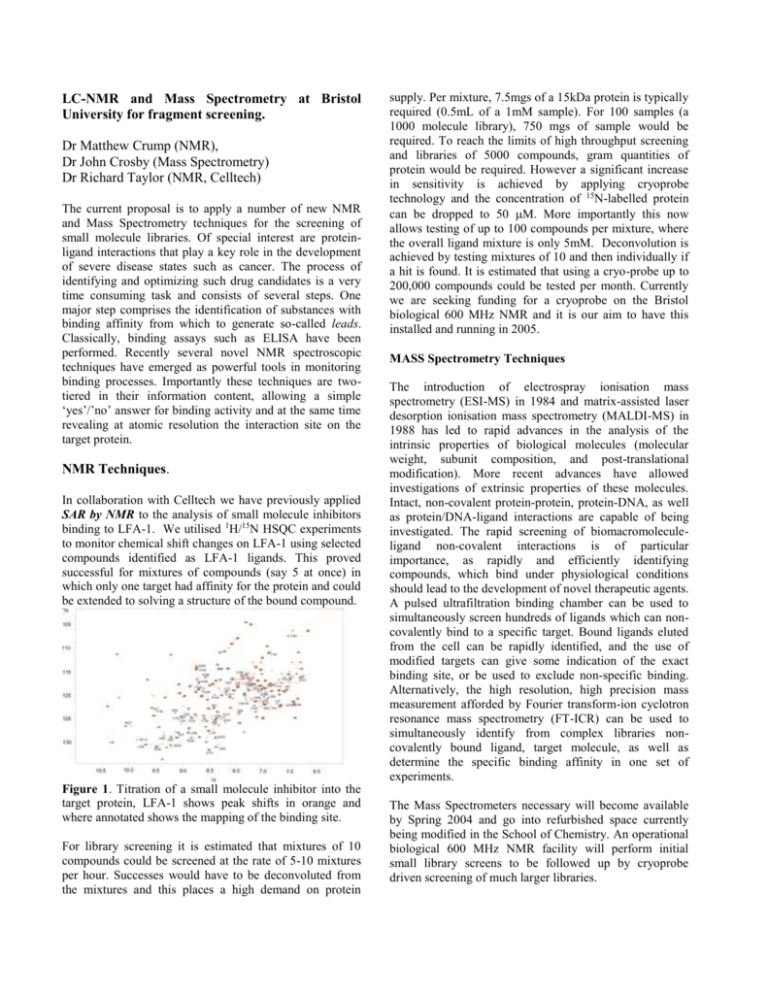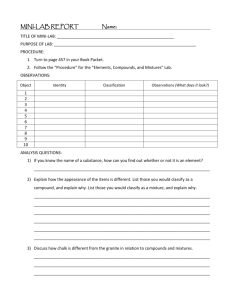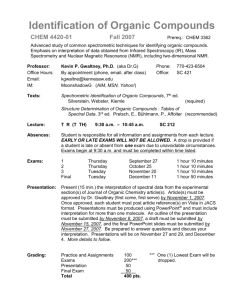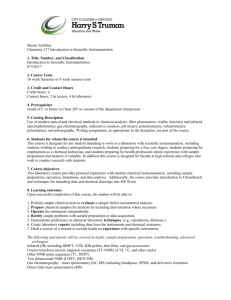LC-NMR and Mass Spectrometry at Bristol University for fragment
advertisement

LC-NMR and Mass Spectrometry at Bristol University for fragment screening. Dr Matthew Crump (NMR), Dr John Crosby (Mass Spectrometry) Dr Richard Taylor (NMR, Celltech) The current proposal is to apply a number of new NMR and Mass Spectrometry techniques for the screening of small molecule libraries. Of special interest are proteinligand interactions that play a key role in the development of severe disease states such as cancer. The process of identifying and optimizing such drug candidates is a very time consuming task and consists of several steps. One major step comprises the identification of substances with binding affinity from which to generate so-called leads. Classically, binding assays such as ELISA have been performed. Recently several novel NMR spectroscopic techniques have emerged as powerful tools in monitoring binding processes. Importantly these techniques are twotiered in their information content, allowing a simple ‘yes’/’no’ answer for binding activity and at the same time revealing at atomic resolution the interaction site on the target protein. NMR Techniques. In collaboration with Celltech we have previously applied SAR by NMR to the analysis of small molecule inhibitors binding to LFA-1. We utilised 1H/15N HSQC experiments to monitor chemical shift changes on LFA-1 using selected compounds identified as LFA-1 ligands. This proved successful for mixtures of compounds (say 5 at once) in which only one target had affinity for the protein and could be extended to solving a structure of the bound compound. Figure 1. Titration of a small molecule inhibitor into the target protein, LFA-1 shows peak shifts in orange and where annotated shows the mapping of the binding site. For library screening it is estimated that mixtures of 10 compounds could be screened at the rate of 5-10 mixtures per hour. Successes would have to be deconvoluted from the mixtures and this places a high demand on protein supply. Per mixture, 7.5mgs of a 15kDa protein is typically required (0.5mL of a 1mM sample). For 100 samples (a 1000 molecule library), 750 mgs of sample would be required. To reach the limits of high throughput screening and libraries of 5000 compounds, gram quantities of protein would be required. However a significant increase in sensitivity is achieved by applying cryoprobe technology and the concentration of 15N-labelled protein can be dropped to 50 M. More importantly this now allows testing of up to 100 compounds per mixture, where the overall ligand mixture is only 5mM. Deconvolution is achieved by testing mixtures of 10 and then individually if a hit is found. It is estimated that using a cryo-probe up to 200,000 compounds could be tested per month. Currently we are seeking funding for a cryoprobe on the Bristol biological 600 MHz NMR and it is our aim to have this installed and running in 2005. MASS Spectrometry Techniques The introduction of electrospray ionisation mass spectrometry (ESI-MS) in 1984 and matrix-assisted laser desorption ionisation mass spectrometry (MALDI-MS) in 1988 has led to rapid advances in the analysis of the intrinsic properties of biological molecules (molecular weight, subunit composition, and post-translational modification). More recent advances have allowed investigations of extrinsic properties of these molecules. Intact, non-covalent protein-protein, protein-DNA, as well as protein/DNA-ligand interactions are capable of being investigated. The rapid screening of biomacromoleculeligand non-covalent interactions is of particular importance, as rapidly and efficiently identifying compounds, which bind under physiological conditions should lead to the development of novel therapeutic agents. A pulsed ultrafiltration binding chamber can be used to simultaneously screen hundreds of ligands which can noncovalently bind to a specific target. Bound ligands eluted from the cell can be rapidly identified, and the use of modified targets can give some indication of the exact binding site, or be used to exclude non-specific binding. Alternatively, the high resolution, high precision mass measurement afforded by Fourier transform-ion cyclotron resonance mass spectrometry (FT-ICR) can be used to simultaneously identify from complex libraries noncovalently bound ligand, target molecule, as well as determine the specific binding affinity in one set of experiments. The Mass Spectrometers necessary will become available by Spring 2004 and go into refurbished space currently being modified in the School of Chemistry. An operational biological 600 MHz NMR facility will perform initial small library screens to be followed up by cryoprobe driven screening of much larger libraries. Plan for CASE As an extensive testable library of ligands is not yet available, we anticipate a series of proof of concept experiments. These could be undertaken during the first year of the CASE studentship at Bristol. To this end we will take a small library of 10 compounds one of which is a known tight binder to an identified target, in this instance LFA-1. The compounds will be selected randomly from the Organic Section and the mixture spiked with a known concentration of CT-8081, that binds LFA-1 with a nM affinity. A series of experiments that we envisage is the use of NMR and pulsed ultrafiltration binding to see if we can detect binding and then deconvolute a simple mixture. We will then increase the number of compounds in the mixture and determine our limits of detection for both techniques. We wish to also explore the possibility of using a mutated protein target where mutations around the binding site or covalently linking a ligand within the active site knock out any specific binding. This nonligand binding target will be used to identify nonspecfically binding compounds, i.e. those that weakly bind at positions other than active site. This approach will then be repeated using the simultaneous screening ability of the FT Mass spectrometer which is already available in the Department of Biochemistry. We hope to have an instrument in-house in 2004. In addition as the cryoprobe becomes available we will extend our new expertise to the use of smaller amounts of target and larger libraries. During the first year of the PhD we will also identify suitable targets of interest to Celltech and begin to prepare protein for NMR and Mass Spectrometry.







